Vintage_Mania
Bachelor Dog
- Joined
- Apr 11, 2012
- Messages
- 11,313
- Reaction score
- 3,217
- Location
- Eersterivier
- Bike
- Triumph 900 Scrambler
And there are just really two that was commercially viable to some degree - The Hercules W2000 and Suzuki RE5.

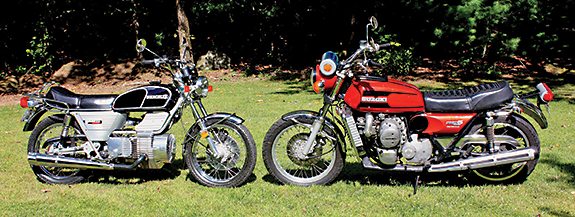
The rotor in the Hercules is situated laterally (across the frame) whereas on the Suzuki the rotor is positioned longitudinally. Each bike’s single-rotor engine has one spark plug. The RE5’s plug is used in no other engine.
In March 1972, Cycle Guide suggested it was “inevitable that the Wankel rotary engine will shortly invade the 2-wheel domain…and they just might take it by storm.” That storm never happened, even though rotary engines would seem good candidates for motorcycles. They’re compact, make good power for their weight and have just two moving parts, the rotor and the crankshaft.
In the 1970s, manufacturers such as Hercules, Norton, Suzuki and Van Veen offered a few rotary-powered motorcycles to the public. First to market was Hercules with its 1975 W2000. Next, and first among major motorcycle companies, was Suzuki with its 1975 RE5.
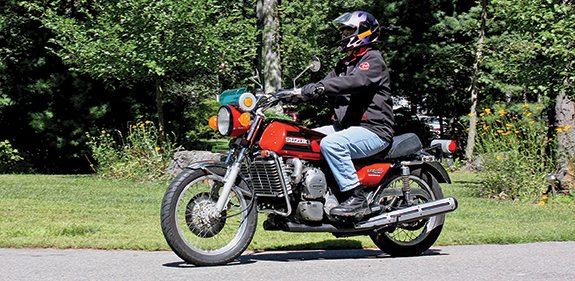
Both the W2000 and RE5 employ a single, three-faced rotor that spins like a Spirograph about an eccentric crankshaft inside the bore (rotor housing). All four engine cycles—intake, compression, ignition and exhaust—occur simultaneously, resulting in smooth power delivery and substantially more heat than is created by a piston engine of similar displacement. Both bikes have a disc brake in front and a drum in the rear, as well as electric and kick start, but many differences make the two distinct.
The Hercules is an exercise in simplicity, with clean, spare design that projects industrial efficiency. It’s light and narrow. The air-cooled engine features finned casings, a cast aluminum fan driven off the crankshaft, and 1-into-2 exhaust that increases the pipes’ surface area to help cool the exhaust.
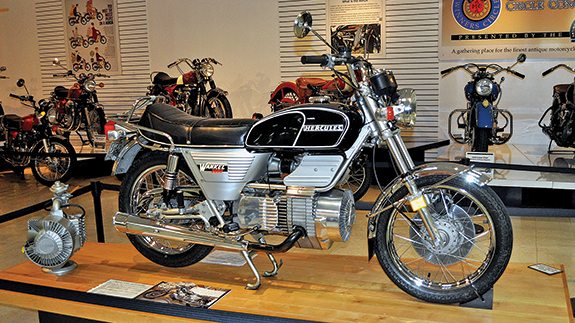
In contrast, Suzuki threw all the technology it could muster at the RE5, including liquid cooling, oil cooling, ram-air intakes to cool 1-into-2 twin-shell exhaust pipes, two-stage carburetion, dual-point ignition and even a spin-on oil filter. Five separate fluid tanks contain gasoline, coolant, engine oil, transmission oil and injection oil. Cycle (August 1975) described Suzuki’s Wankel engine as “pleasantly simple in the abstract and astonishingly complex in reality.”
Ron Schavrien, a paramedic from Millville, Massachusetts, owns a 1976 Hercules W2000 and a 1975 Suzuki RE5. They’re part of his collection of “orphan bikes” that he describes as innovative but not commercially successful.
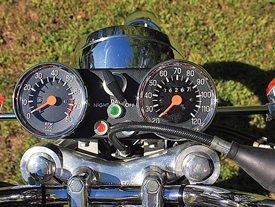
The 1976 Hercules W2000’s 6,500 rpm redline arrived quickly. The speedo’s 120mph top speed was wishful thinking.
His W2000 is 100-percent original unrestored. Most of the 1,784 W2000 models built were gas/oil premix models, but 199 were built with oil-injection, including this example. It’s also the only W2000 that had its motor and transmission factory polished, because this bike was displayed at Sachs’s headquarters. The bike has been judged by the Antique Motorcycle Club and won Winner’s Circle honors. The RE5 is complete but not 100-percent correct, as the previous owner had the directional housings chromed. Both bikes are registered and Schavrien rides them. He offered your humble scribe the opportunity to take each for a spin (that’s rotary engine humor).
The W2000’s Sachs-built Wankel engine fired up with a bit of smoke and a sound unlike any motorcycle I’ve heard—nasal and raw, like two-stroke meets four-stroke without the power pulses of a piston engine.
I pulled the bike upright and the sidestand retracted automatically—a nifty feature that also made it tricky to make the stand stay down. There were some unusual controls, including turn signals on the right handlebar positioned beyond the reach of my thumb. Rather than take my hand off the throttle before each turn, I used hand signals. The throttle grip was oval, not round, a feature specific to the 1976 model.
On the road, acceleration was smooth, linear…and slow. Sachs designed this small-displacement, air-cooled rotary engine for constant-speed industrial and agricultural applications, so leisurely time to speed was no surprise. The 6,500 rpm redline arrived quickly, but the 6-speed transmission made the most of available output. The bike corners like a lightweight, although there’s little torque for powering out of turns. The motor hums out enough power for highway speed, and with little mass to slow, the brakes work well.
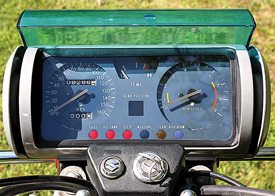
Distinctive Suzuki RE5 gauge cluster cover pops open when the key is turned to ON. Note the digital gear position indicator.
On the RE5, everything felt bigger, taller, wider and heavier. The massive radiator hinted at the cooling required by the 497cc Wankel. The cylindrical gauge cluster had an integrated visor to protect the gauges while the bike was parked. When the ignition key was turned to ON, the visor slid up to give the rider a clean view of the gauges, which included a temperature gauge, lights for low fuel and low injection oil, and a digital gear position indicator. The taillight carried on the cylindrical design theme. In the cockpit, rider controls were right where you’d expect to find them on a Japanese motorcycle.
On the road, the RE5’s power advantage was instantly clear, with much stronger acceleration. The exhaust note was deeper than the W2000, but still raspy and boisterous. Power peaked well before redline and then plummeted, so short shifting aided acceleration. Suzuki marketed the RE5 as a tourer and it felt happier at speed than the Hercules.
Riding each bike was fun in its own way, and the looks on people’s faces (“What the….”) as we hummed past enhanced the experience. As a fan of simple-is-good design, I’d likely choose the Hercules if adding a rotary-powered bike to my stable. This particular W2000, however, won’t qualify for that honor. Schavrien’s 1976 Hercules W2000 is now on display at the Motorcyclepedia Museum in Newburgh, New York. It’s not every day you get to ride a museum piece.
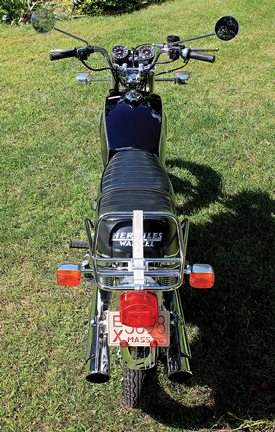
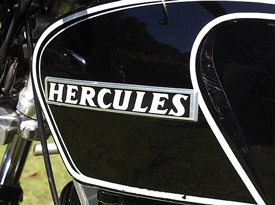
1976 Hercules W2000
Country: West Germany
Production: Model years 1975-76
Engine Type: Single disc Wankel 4-stroke
Displacement: 294cc
Power: 27hp @ 6,000 rpm (claimed)
Compression: 8.5:1
Valves: None
Cooling: Air-cooling by draught and blower
Carburetion: Single Bing 32mm carburetor
Starting: Electric starter and kick-start
Transmission: 6-speed
Dry Weight: 381 lbs. (claimed)
Cost: R1720 new in 1976 (with the 1976 R/$ exchange rate)
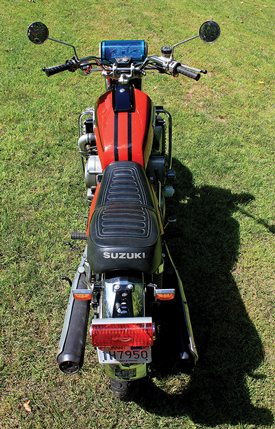
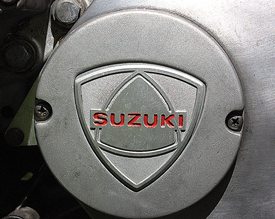
1975 Suzuki RE5
Country: Japan
Production: Model years 1975-76
Engine Type: Single disc Wankel 4-stroke
Displacement: 497cc
Power: 62 hp @ 6,500 rpm (claimed)
Compression: 9.4:1
Valves: None
Cooling: Liquid cooled, oil cooled, air-cooled exhaust
Carburetion: Two stage, two barrel 18-32mm Mikuni
Starting: Electric starter and kick-start
Transmission: 5-speed
Dry Weight: 507 lbs. (claimed)
Cost: R2230 new in 1975 (with the 1975 R/$ exchange rate)


The rotor in the Hercules is situated laterally (across the frame) whereas on the Suzuki the rotor is positioned longitudinally. Each bike’s single-rotor engine has one spark plug. The RE5’s plug is used in no other engine.
In March 1972, Cycle Guide suggested it was “inevitable that the Wankel rotary engine will shortly invade the 2-wheel domain…and they just might take it by storm.” That storm never happened, even though rotary engines would seem good candidates for motorcycles. They’re compact, make good power for their weight and have just two moving parts, the rotor and the crankshaft.
In the 1970s, manufacturers such as Hercules, Norton, Suzuki and Van Veen offered a few rotary-powered motorcycles to the public. First to market was Hercules with its 1975 W2000. Next, and first among major motorcycle companies, was Suzuki with its 1975 RE5.

Both the W2000 and RE5 employ a single, three-faced rotor that spins like a Spirograph about an eccentric crankshaft inside the bore (rotor housing). All four engine cycles—intake, compression, ignition and exhaust—occur simultaneously, resulting in smooth power delivery and substantially more heat than is created by a piston engine of similar displacement. Both bikes have a disc brake in front and a drum in the rear, as well as electric and kick start, but many differences make the two distinct.
The Hercules is an exercise in simplicity, with clean, spare design that projects industrial efficiency. It’s light and narrow. The air-cooled engine features finned casings, a cast aluminum fan driven off the crankshaft, and 1-into-2 exhaust that increases the pipes’ surface area to help cool the exhaust.

In contrast, Suzuki threw all the technology it could muster at the RE5, including liquid cooling, oil cooling, ram-air intakes to cool 1-into-2 twin-shell exhaust pipes, two-stage carburetion, dual-point ignition and even a spin-on oil filter. Five separate fluid tanks contain gasoline, coolant, engine oil, transmission oil and injection oil. Cycle (August 1975) described Suzuki’s Wankel engine as “pleasantly simple in the abstract and astonishingly complex in reality.”
Ron Schavrien, a paramedic from Millville, Massachusetts, owns a 1976 Hercules W2000 and a 1975 Suzuki RE5. They’re part of his collection of “orphan bikes” that he describes as innovative but not commercially successful.

The 1976 Hercules W2000’s 6,500 rpm redline arrived quickly. The speedo’s 120mph top speed was wishful thinking.
His W2000 is 100-percent original unrestored. Most of the 1,784 W2000 models built were gas/oil premix models, but 199 were built with oil-injection, including this example. It’s also the only W2000 that had its motor and transmission factory polished, because this bike was displayed at Sachs’s headquarters. The bike has been judged by the Antique Motorcycle Club and won Winner’s Circle honors. The RE5 is complete but not 100-percent correct, as the previous owner had the directional housings chromed. Both bikes are registered and Schavrien rides them. He offered your humble scribe the opportunity to take each for a spin (that’s rotary engine humor).
The W2000’s Sachs-built Wankel engine fired up with a bit of smoke and a sound unlike any motorcycle I’ve heard—nasal and raw, like two-stroke meets four-stroke without the power pulses of a piston engine.
I pulled the bike upright and the sidestand retracted automatically—a nifty feature that also made it tricky to make the stand stay down. There were some unusual controls, including turn signals on the right handlebar positioned beyond the reach of my thumb. Rather than take my hand off the throttle before each turn, I used hand signals. The throttle grip was oval, not round, a feature specific to the 1976 model.
On the road, acceleration was smooth, linear…and slow. Sachs designed this small-displacement, air-cooled rotary engine for constant-speed industrial and agricultural applications, so leisurely time to speed was no surprise. The 6,500 rpm redline arrived quickly, but the 6-speed transmission made the most of available output. The bike corners like a lightweight, although there’s little torque for powering out of turns. The motor hums out enough power for highway speed, and with little mass to slow, the brakes work well.

Distinctive Suzuki RE5 gauge cluster cover pops open when the key is turned to ON. Note the digital gear position indicator.
On the RE5, everything felt bigger, taller, wider and heavier. The massive radiator hinted at the cooling required by the 497cc Wankel. The cylindrical gauge cluster had an integrated visor to protect the gauges while the bike was parked. When the ignition key was turned to ON, the visor slid up to give the rider a clean view of the gauges, which included a temperature gauge, lights for low fuel and low injection oil, and a digital gear position indicator. The taillight carried on the cylindrical design theme. In the cockpit, rider controls were right where you’d expect to find them on a Japanese motorcycle.
On the road, the RE5’s power advantage was instantly clear, with much stronger acceleration. The exhaust note was deeper than the W2000, but still raspy and boisterous. Power peaked well before redline and then plummeted, so short shifting aided acceleration. Suzuki marketed the RE5 as a tourer and it felt happier at speed than the Hercules.
Riding each bike was fun in its own way, and the looks on people’s faces (“What the….”) as we hummed past enhanced the experience. As a fan of simple-is-good design, I’d likely choose the Hercules if adding a rotary-powered bike to my stable. This particular W2000, however, won’t qualify for that honor. Schavrien’s 1976 Hercules W2000 is now on display at the Motorcyclepedia Museum in Newburgh, New York. It’s not every day you get to ride a museum piece.


1976 Hercules W2000
Country: West Germany
Production: Model years 1975-76
Engine Type: Single disc Wankel 4-stroke
Displacement: 294cc
Power: 27hp @ 6,000 rpm (claimed)
Compression: 8.5:1
Valves: None
Cooling: Air-cooling by draught and blower
Carburetion: Single Bing 32mm carburetor
Starting: Electric starter and kick-start
Transmission: 6-speed
Dry Weight: 381 lbs. (claimed)
Cost: R1720 new in 1976 (with the 1976 R/$ exchange rate)


1975 Suzuki RE5
Country: Japan
Production: Model years 1975-76
Engine Type: Single disc Wankel 4-stroke
Displacement: 497cc
Power: 62 hp @ 6,500 rpm (claimed)
Compression: 9.4:1
Valves: None
Cooling: Liquid cooled, oil cooled, air-cooled exhaust
Carburetion: Two stage, two barrel 18-32mm Mikuni
Starting: Electric starter and kick-start
Transmission: 5-speed
Dry Weight: 507 lbs. (claimed)
Cost: R2230 new in 1975 (with the 1975 R/$ exchange rate)




